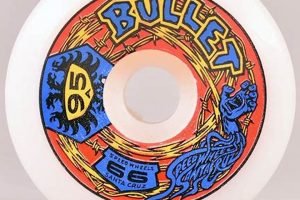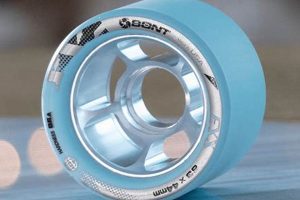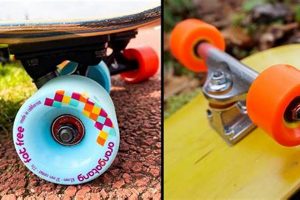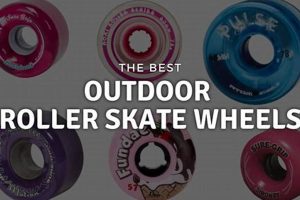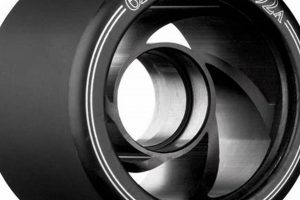Durometer, a measurement of a material’s hardness, is a key factor in determining the performance characteristics of polyurethane wheels designed for skateboarding and related activities. A rating of 95A on the durometer scale indicates a specific level of firmness, offering a balance between grip and slide. Wheels with this rating are commonly used in street skating and park skating, providing responsiveness on various surfaces.
This level of hardness translates to enhanced durability and resistance to abrasion compared to softer wheels. The balance between grip and slide facilitates tricks and maneuvers requiring controlled slides, while still offering sufficient traction for acceleration and maintaining speed. The popularity of this durometer rating stems from its versatility, making it suitable for skaters of varying skill levels and skating styles. The development of improved polyurethane compounds has further refined the performance of wheels with this hardness, contributing to their continued prevalence in the skateboarding market.
Considering these factors, further discussion will focus on specific aspects of selecting appropriate wheels, including size, profile, and core design, to optimize performance based on individual skating preferences and intended use.
Optimizing Performance
The following guidelines provide practical advice for maximizing the performance and lifespan of wheels with a 95A durometer rating, catering to skaters focused on street and park environments.
Tip 1: Surface Selection: The 95A hardness is suited for smooth concrete and asphalt. Rougher surfaces will increase wear and reduce speed. Consider the surface quality before initiating a session.
Tip 2: Regular Rotation: Consistent rotation of the wheels will ensure even wear across all contact surfaces. Rotate wheels in a cross pattern (front left to back right, etc.) after each session to prolong their lifespan and maintain consistent performance.
Tip 3: Bearing Maintenance: Clean and lubricate bearings regularly to minimize friction and optimize speed. Debris accumulation within the bearings compromises wheel performance, regardless of durometer.
Tip 4: Weight Distribution: Distribute weight evenly across the board to prevent uneven wear patterns on the wheels. Shifting weight dynamically during maneuvers is crucial for preserving wheel integrity.
Tip 5: Avoiding Extreme Heat: Prolonged exposure to extreme heat can alter the structural integrity of the polyurethane compound. Avoid leaving the board in direct sunlight or excessively hot environments for extended periods.
Tip 6: Controlled Slides: While designed for controlled slides, excessive or prolonged sliding can accelerate wear. Moderate the duration and frequency of slides to maximize wheel longevity.
These guidelines, when followed consistently, will contribute to extended wheel life and optimized performance within the intended application. By incorporating these practices, skaters can maximize their investment and enhance their overall experience.
With a solid understanding of wheel care and suitable application, the article will now proceed to discuss the relationship between wheel size and skating discipline.
1. Durometer Hardness
Durometer hardness is a critical material property influencing the performance characteristics of skateboard wheels. For wheels identified as “95a,” the durometer rating specifies the wheel’s resistance to indentation, directly impacting grip, speed, and overall suitability for various skateboarding styles.
- Grip and Slide Characteristics
A 95A durometer provides a balance between grip and slide. The “A” scale, commonly used for skateboard wheels, indicates a relatively hard compound. Wheels in this range offer sufficient grip for maintaining control during carving and turning maneuvers, while also allowing for controlled slides, essential in street and park skating. For instance, a skater executing a powerslide requires a wheel with a degree of hardness to initiate the slide without excessive friction, a feature facilitated by the 95A rating.
- Rolling Resistance and Speed
Harder wheels generally exhibit lower rolling resistance on smooth surfaces, resulting in higher speeds. A 95A durometer offers efficient energy transfer, allowing skaters to maintain momentum with less effort. In a skate park environment, this translates to increased speed for clearing obstacles and executing tricks that require momentum. This characteristic is advantageous for skaters prioritizing speed and responsiveness.
- Surface Compatibility and Durability
The 95A rating provides acceptable performance on smooth surfaces like skate park concrete and well-maintained asphalt. While not as forgiving as softer wheels on rougher surfaces, 95A wheels offer enhanced durability and resistance to abrasion. Street skaters often encounter varied terrain, making abrasion resistance a key factor. The 95A durometer strikes a compromise, offering sufficient durability without sacrificing performance on common street surfaces.
- Impact Absorption and Ride Comfort
Wheels of 95A hardness exhibit limited impact absorption compared to softer compounds. While providing a responsive feel and direct feedback from the riding surface, they may transmit more vibrations and impacts to the skater, potentially affecting comfort during extended sessions. This characteristic is important for skaters to consider when choosing wheels, especially if they are prone to skating on uneven surfaces or prioritizing comfort over maximum responsiveness.
The implications of durometer hardness, specifically the 95A rating, are multifaceted. The choice of this hardness represents a compromise among grip, speed, durability, and comfort. Skaters must evaluate their individual preferences and the environments in which they typically skate to determine if the 95A rating aligns with their specific needs.
2. Grip versus Slide
The balance between grip and slide is a fundamental characteristic of skateboard wheels, directly influencing a skater’s ability to execute maneuvers and maintain control. In the context of wheels designated as 95A, the durometer rating dictates the extent to which the wheel adheres to or slides across the riding surface. A 95A wheel represents a midpoint on the hardness spectrum, designed to offer a compromise between secure traction and controlled slippage. The effects of this balance are observable in various skateboarding disciplines. For example, in street skating, a skater may need to initiate a controlled slide to avoid an obstacle or maintain balance during a trick. A wheel with excessive grip would hinder this maneuver, while a wheel with insufficient grip would result in a loss of control. Therefore, the 95A durometer aims to provide sufficient adhesion for maintaining speed and stability, while simultaneously allowing for the controlled slides necessary for navigating urban environments.
The importance of this grip-slide dynamic extends to park skating, where transitions and ramps demand both traction and the capacity for controlled adjustments. Wheels rated 95A facilitate carving and maintaining speed through corners, allowing skaters to generate momentum. However, they also permit the controlled slides required for correcting minor imbalances or adjusting trajectories mid-air. The significance of this balance is further underscored by the material properties of polyurethane. Different polyurethane formulations can influence the specific grip and slide characteristics of a 95A wheel, even within the same durometer rating. This highlights the necessity of understanding the underlying composition and construction of skateboard wheels beyond simply the durometer rating.
In conclusion, the grip-slide relationship within 95A wheels is a critical determinant of skateboarding performance. This balance is crucial for executing various tricks, navigating diverse terrain, and maintaining overall control. While the 95A durometer offers a generally accepted midpoint, the actual performance can be nuanced by variations in polyurethane formulations and manufacturing processes. This underlines the importance of considering multiple factors when selecting wheels, with a thorough understanding of the intended application and skating style.
3. Surface Compatibility
Surface compatibility is a critical determinant of the performance and lifespan of skateboard wheels. The interaction between wheel durometer and surface texture directly impacts grip, speed, and wear. Wheels with a 95A durometer exhibit specific performance characteristics depending on the riding surface.
- Smooth Concrete and Skateparks
Smooth concrete surfaces, such as those found in skateparks, are optimal for 95A wheels. The hardness provides efficient energy transfer, maximizing speed and roll distance. The smooth surface minimizes abrasion, extending wheel lifespan. Tricks requiring precise execution benefit from the predictable grip offered by 95A wheels on this surface. Therefore, a 95A durometer excels in these controlled environments.
- Asphalt and Street Skating
Asphalt presents a more varied surface, ranging from smooth to coarse. 95A wheels perform adequately on smoother asphalt, offering a balance between speed and grip. However, rough asphalt increases friction and wear. Street skaters often encounter these diverse conditions, necessitating awareness of the trade-offs between wheel performance and durability. Regular wheel rotation becomes crucial in this context.
- Wooden Surfaces and Indoor Parks
Wooden surfaces, common in indoor skateparks, provide a unique riding experience. 95A wheels generally perform well on sealed wood, offering a consistent and predictable grip. The smooth surface reduces abrasion compared to outdoor environments. However, unsealed or splintered wood can negatively impact wheel performance and longevity. The suitability of 95A wheels on wood is contingent upon the surface’s condition.
- Rough and Uneven Terrain
Rough or uneven terrain poses significant challenges for 95A wheels. The hardness reduces shock absorption, leading to a less comfortable ride. Increased friction diminishes speed and accelerates wear. Furthermore, the reduced grip on uneven surfaces compromises control, increasing the risk of accidents. In such environments, softer wheels are generally preferable.
The performance of 95A wheels is intrinsically linked to surface conditions. While they excel on smooth concrete and perform adequately on smoother asphalt and sealed wood, rough and uneven terrain diminishes their effectiveness. Understanding these surface-specific characteristics enables skaters to make informed decisions regarding wheel selection and usage, optimizing both performance and longevity.
4. Abrasion Resistance
Abrasion resistance, the ability of a material to withstand wear from rubbing or friction, is a critical performance parameter for skateboard wheels. For wheels designated with a 95A durometer rating, this characteristic directly influences their lifespan, performance consistency, and overall value proposition.
- Polyurethane Formulation
The specific polyurethane compound used in the manufacturing process significantly impacts abrasion resistance. Certain formulations are inherently more resistant to wear, even within the same durometer range. Additives, such as specific polymers or fillers, can further enhance this property. Wheels manufactured with superior polyurethane formulations will exhibit prolonged lifespan and consistent performance under abrasive conditions.
- Wheel Contact Patch
The area of the wheel in contact with the riding surface, known as the contact patch, also affects abrasion resistance. A smaller contact patch concentrates the force of friction onto a smaller area, potentially accelerating wear. Conversely, a larger contact patch distributes the force, potentially reducing wear. The design of the wheel profile, including its width and shape, influences the size and shape of the contact patch.
- Riding Surface Conditions
The nature of the riding surface exerts a considerable influence on the abrasion rate. Rough surfaces, such as coarse asphalt or concrete, dramatically increase wear compared to smooth surfaces like polished concrete or indoor skatepark floors. The presence of debris, such as sand or gravel, further exacerbates the abrasive effects. Skaters who frequently ride on rough surfaces should anticipate reduced wheel lifespan.
- Skating Style and Usage Patterns
Skating style and usage patterns directly influence abrasion resistance. Aggressive skating styles, involving frequent sliding or prolonged contact with rough surfaces, accelerate wear. Similarly, skaters who spend extended periods riding on abrasive surfaces will experience faster wheel degradation. Conversely, skaters who primarily ride on smooth surfaces and avoid excessive sliding will observe increased wheel longevity.
The interplay between polyurethane formulation, wheel contact patch, riding surface conditions, and skating style dictates the abrasion resistance of 95A wheels. Understanding these factors enables skaters to make informed decisions regarding wheel selection and usage patterns, optimizing wheel lifespan and maintaining consistent performance. Furthermore, advancements in polyurethane technology continue to drive improvements in abrasion resistance, extending the durability and value of these components.
5. Rolling Speed
The rolling speed of skateboard wheels is significantly influenced by their durometer, with the 95A rating representing a specific point on the spectrum. A wheel’s durometer affects its deformation under load, directly impacting its ability to maintain momentum. Harder wheels, such as those rated 95A, deform less, reducing energy loss due to hysteresis. This translates to a higher rolling speed on smooth surfaces like concrete or asphalt. For example, a skater traversing a flat stretch of skatepark concrete will experience faster and more efficient movement with 95A wheels compared to softer alternatives. This speed advantage is crucial for maintaining flow and executing tricks requiring momentum. Thus, rolling speed is an integral performance characteristic directly impacted by the 95A durometer.
However, the relationship between durometer and rolling speed is not absolute; surface conditions play a mediating role. On rougher surfaces, harder wheels may experience increased vibration and energy loss, diminishing their speed advantage. In such scenarios, softer wheels, which conform more readily to surface irregularities, might maintain momentum more effectively. The practical application of this understanding lies in selecting wheels appropriate for the intended skating environment. Street skaters, who often encounter varied and unpredictable surfaces, must weigh the benefits of increased rolling speed against the potential for reduced comfort and control on rough terrain. Furthermore, bearing quality and wheel diameter also contribute to overall rolling speed, interacting with the durometer to determine performance.
In conclusion, rolling speed is a key performance attribute of skateboard wheels that is significantly affected by the 95A durometer rating. While 95A wheels generally offer enhanced rolling speed on smooth surfaces due to reduced deformation, surface conditions and other factors can modulate this effect. Understanding these interactions is crucial for optimizing wheel selection and achieving desired skating performance. The challenge lies in balancing the benefits of increased rolling speed with the demands of varied skating environments, a consideration that requires careful evaluation of both wheel characteristics and terrain.
6. Trick Execution
The successful execution of skateboarding tricks is intrinsically linked to the performance characteristics of the equipment used, with wheel durometer playing a significant role. Wheels designated with a 95A durometer rating offer a specific balance of grip and slide, influencing a skater’s ability to perform various maneuvers effectively. This hardness rating is commonly favored in street and park skating due to its versatility and responsiveness.
- Ollie Pop and Landing Stability
The “ollie,” a foundational skateboarding trick, requires a sharp upward pop from the board. Wheels with a 95A durometer provide a firm platform for generating this pop, transferring energy efficiently from the skater’s movement to the board. Upon landing, the wheel hardness offers stability, minimizing compression and maintaining control. For example, a skater attempting a high ollie benefits from the responsive feel of 95A wheels, enabling a clean pop and a stable landing. The implications extend to more complex flip tricks, where consistent board control is paramount.
- Slide Control During Grinds and Slides
Grinding and sliding tricks involve controlled friction between the board and a surface, such as a rail or ledge. Wheels with a 95A durometer facilitate controlled slides, allowing skaters to maintain balance and maneuverability during these tricks. The hardness provides a balance between grip and slide, preventing excessive friction while still allowing for controlled movement. A skater performing a boardslide, for instance, requires wheels that slide smoothly without catching, a characteristic provided by the 95A rating. The implication is increased consistency and predictability in grind and slide trick execution.
- Responsiveness for Flip Tricks
Flip tricks, such as kickflips and heelflips, require rapid board rotation. Wheels with a 95A durometer provide a responsive feel, allowing skaters to quickly initiate and control the rotation. The hardness minimizes energy absorption, resulting in a more direct connection between the skater’s input and the board’s movement. A skater executing a kickflip benefits from the quick response of 95A wheels, enabling precise control over the board’s rotation and landing. The implications include increased consistency and precision in executing technical flip tricks.
- Speed Maintenance for Transition Skating
Transition skating, involving ramps and bowls, relies on maintaining speed and momentum. Wheels with a 95A durometer offer efficient rolling speed on smooth surfaces, allowing skaters to maintain flow and execute tricks with sufficient momentum. The hardness minimizes rolling resistance, enabling skaters to generate and sustain speed through transitions. A skater carving through a bowl benefits from the speed provided by 95A wheels, allowing for smooth transitions and dynamic maneuvers. The implications extend to aerial tricks performed on transitions, where sufficient speed is essential for successful execution.
The influence of 95A wheels on trick execution is multifaceted, impacting ollie pop, landing stability, slide control, flip trick responsiveness, and speed maintenance. These characteristics contribute to a skater’s ability to perform a wide range of tricks with consistency and precision. While other factors, such as bearing quality and wheel size, also play a role, the durometer of the wheels is a fundamental consideration for skaters seeking to optimize their performance.
7. Versatility
The 95A durometer rating for skateboard wheels is often associated with versatility due to its balanced performance across a range of skateboarding disciplines. This rating provides a compromise between the grip necessary for controlled maneuvers and the slide characteristics required for certain tricks and transitions. Consequently, wheels of this hardness are frequently selected by skaters who engage in diverse skateboarding activities, rather than specializing in a single style. For example, a skater who transitions between street skating, park skating, and occasional vert riding may find 95A wheels suitable for these varied environments. This contrasts with softer wheels, which excel on rough surfaces but lack the necessary slide for street tricks, or harder wheels, which offer high speed but reduced grip on transitions.
The practical significance of this versatility stems from the ability of a single set of wheels to perform adequately in multiple contexts, reducing the need for frequent wheel changes or the acquisition of multiple sets of wheels. This can be particularly advantageous for beginner and intermediate skaters who are still exploring different skateboarding styles and have not yet developed a strong preference for a specific discipline. Furthermore, the 95A durometer provides a predictable and consistent riding experience across a range of surfaces, fostering confidence and facilitating skill development. The impact of this is observable in the increased adoption of 95A wheels by skaters of varied skill levels and skating styles. The versatility of these wheels makes them a solid all-around choice.
In summary, the versatility of 95A skateboard wheels derives from their balanced performance characteristics, enabling their effective use across a variety of skateboarding disciplines. This adaptability reduces the need for specialized equipment and provides a consistent riding experience, making them a popular choice for skaters with diverse skill sets and preferences. While specialized wheels may offer superior performance in specific contexts, the versatility of 95A wheels provides a pragmatic solution for skaters seeking a single set of wheels suitable for a range of activities, underlining the value of a balanced performance profile in skateboarding equipment.
Frequently Asked Questions
The following addresses common inquiries regarding skateboard wheels with a 95A durometer rating. This information is intended to provide clarity and promote informed decision-making.
Question 1: What is the significance of the “A” in the 95A designation?
The “A” denotes the durometer scale used for measuring the hardness of skateboard wheels, specifically polyurethane compounds. This scale ranges from 0A to 100A, with higher numbers indicating greater hardness. The 95A rating signifies a relatively hard wheel, commonly used in street and park skating.
Question 2: Are 95A wheels suitable for beginners?
95A wheels can be suitable for beginners, particularly those focusing on skateparks or smooth surfaces. The hardness provides stability and responsiveness. However, beginners should consider that softer wheels offer greater shock absorption on rougher terrain, potentially enhancing comfort during the learning process.
Question 3: How does wheel size relate to durometer?
Wheel size and durometer are distinct characteristics. Wheel size (diameter) influences speed and acceleration, while durometer affects grip and slide. Both factors should be considered in tandem to optimize performance based on individual skating style and terrain preferences.
Question 4: Can 95A wheels be used for longboarding?
While 95A wheels can be used on longboards, they are generally not optimal for distance cruising or downhill riding. Softer wheels typically provide a smoother ride and better grip at higher speeds, making them more suitable for longboarding applications. 95A wheels on a longboard would be best suited to trick-based skating.
Question 5: How does surface texture affect the performance of 95A wheels?
Smooth surfaces, such as skatepark concrete, maximize the performance of 95A wheels, allowing for efficient rolling speed and predictable grip. Rougher surfaces increase friction and wear, potentially reducing speed and control. The 95A durometer, while durable, is not as forgiving as softer wheels on uneven terrain.
Question 6: How can wheel lifespan be extended?
Wheel lifespan can be extended through regular rotation, which ensures even wear across all wheels. Avoiding prolonged sliding on abrasive surfaces, maintaining clean bearings, and storing the skateboard in a cool, dry environment are additional measures to prolong wheel longevity.
In summary, 95A wheels offer a balanced approach, performing well on many surfaces and skating styles. However, wheel selection depends on skating experience, terrain, and preferred style.
The following section will explore the future trends related to wheels with a 95A durometer.
95a skate wheels
The preceding exploration has examined the characteristics, benefits, and limitations associated with skateboard wheels bearing a 95A durometer rating. This analysis has encompassed considerations of grip, slide, surface compatibility, abrasion resistance, rolling speed, trick execution, and overall versatility. The investigation has revealed that wheels of this hardness offer a balanced performance profile, suitable for a range of skateboarding disciplines and skill levels, particularly within street and park contexts. However, the optimal application remains contingent upon individual skater preferences, terrain conditions, and intended use cases.
The understanding of the nuances presented within this assessment is paramount for making informed equipment choices. As advancements in materials science continue to refine the performance capabilities of skateboarding components, a critical and discerning approach to product selection will remain essential for optimizing both the skating experience and the longevity of the equipment. Further research and analysis may yield insights into tailored wheel designs that better address the specific needs of diverse skateboarding communities. The ongoing pursuit of performance enhancements within this domain holds significant implications for the future of the sport.


